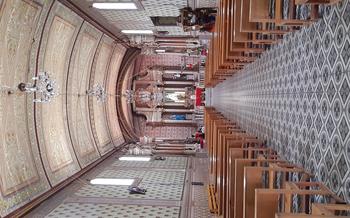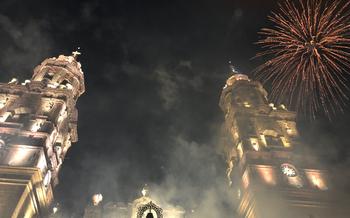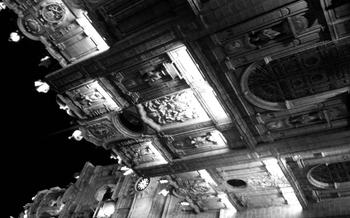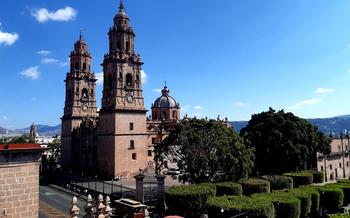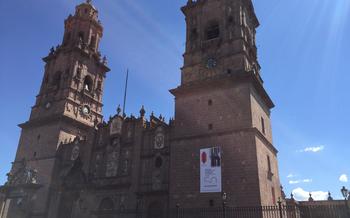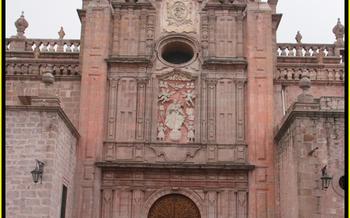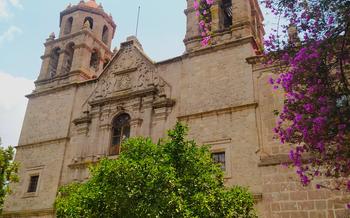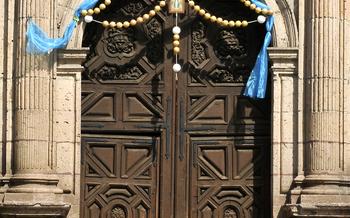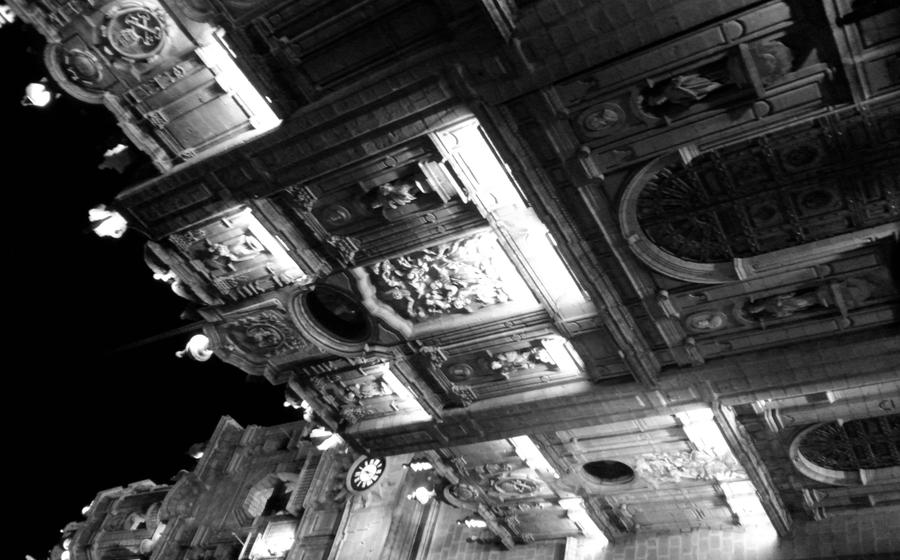
Plaza Chica en Pátzcuaro
- Exploring the Plaza Chica: A Visual Masterpiece
- Basílica de Nuestra Señora de la Salud: A Sacred Sanctuary
- Museo de Artes e Industrias Populares: A Celebration of Craftsmanship
- Mercado de Artesanías: A Shopper's Paradise
- Casa de los Once Patios: A Hidden Architectural Jewel
- Teatro Emperador Caltzontzin: A Cultural Landmark
- Plazuela de San Francisco: A Tranquil Oasis
- Iglesia de San Francisco: A Gothic Masterpiece
- Casa del Gigante: A Unique Accommodation Experience
- Taking a Boat Ride: Exploring Lake Pátzcuaro
- Janitzio Island: A Mystical Journey
- Visiting Indigenous Villages: A Glimpse into Local Life
- Insider Tip: Finding the Hidden Gems
Exploring the Plaza Chica: A Visual Masterpiece
The Plaza Chica, or Little Plaza, is a smaller, hidden square located just a few steps away from the bustling Plaza Grande. However, don't let its size fool you – this charming square is a visual masterpiece that embodies the essence of Pátzcuaro's rich cultural heritage.
The plaza's unique design sets it apart from other squares in the city. Its irregular shape and narrow cobblestone streets create a sense of intimacy and seclusion, making it a perfect spot to escape the crowds and soak in the tranquil atmosphere.
The buildings surrounding the Plaza Chica showcase a vibrant array of colorful facades, each featuring intricate designs and unique architectural elements. Pastel hues of pink, yellow, blue, and green adorn the walls, creating a harmonious and visually stunning ensemble.
Ornate balconies, a hallmark of Pátzcuaro's colonial architecture, grace the buildings' upper levels. These balconies, with their intricate wrought-iron railings and delicate carvings, add a touch of elegance and charm to the square. They also provide a glimpse into the lives of the people who lived and worked here centuries ago, as they would often sit on the balconies to socialize and enjoy the fresh air.
Basílica de Nuestra Señora de la Salud: A Sacred Sanctuary
The Basílica de Nuestra Señora de la Salud, also known as the Santuario de Nuestra Señora de la Salud, is a magnificent architectural marvel that stands as the centerpiece of the Plaza Chica. Built in the 16th century, this and Renaissance architectural styles, which is evident in its intricate stone carvings, arched doorways, and vaulted ceilings. Its imposing facade features a series of niches that house sculptures depicting various saints and religious figures. The interior of the basilica is equally impressive, with its ornate altars, stained glass windows, and a stunning altarpiece that depicts the life of the Virgin Mary.
Religious Significance
The Basílica de Nuestra Señora de la Salud is a sacred site for the people of Pátzcuaro and the surrounding region. It is dedicated to the Virgin Mary, who is revered as the patron saint of the city. Each year, on the 8th of September, thousands of pilgrims flock to the basilica to celebrate the Feast of the Nativity of the Virgin Mary, an event that draws visitors from far and wide.
History and Legends
The history of the basilica is intertwined with numerous legends and stories that have been passed down through generations. One of the most popular tales is that the Virgin Mary appeared to a local shepherdess named Juana Catarina in 1530. Juana Catarina is said to have been instructed by the Virgin Mary to build a church on the site where she had appeared. The basilica was subsequently constructed on that very spot, and it has remained a place of pilgrimage and devotion ever since.
Museo de Artes e Industrias Populares: A Celebration of Craftsmanship
The Museo de Artes e Industrias Populares, located just off the Plaza Chica, is a treasure trove of traditional Mexican handicrafts. This charming museum showcases the diverse artistry of local artisans, offering an immersive journey into the rich cultural heritage of the region.
With a vast collection of handcrafted items, the museum presents a diverse array of techniques, materials, and artistic expressions. Visitors can admire intricate pottery, colorful textiles, delicate blown glass, and finely carved wooden sculptures, each piece a testament to the skill and creativity of Michoacán's artisans.
Beyond its artistic value, the museum plays a vital role in preserving and promoting local craftsmanship. It supports the local economy by providing a platform for artisans to showcase and sell their work, ensuring the continuation of traditional techniques and designs.
Exploring the Museo de Artes e Industrias Populares is an enriching experience that offers visitors a deep appreciation for the vibrant culture and artistry of Michoacán.
Mercado de Artesanías: A Shopper's Paradise
Nestled in the heart of Pátzcuaro, the Mercado de Artesanías enchants visitors with its vibrant array of traditional handicrafts. From intricate pottery and finely woven textiles to hand-painted ceramics and delicate silver jewelry, this bustling market offers a treasure trove of unique souvenirs and keepsakes.
Lose yourself in the maze-like alleys, where each stall proudly displays its artisan's creations. Admire the vibrant colors, intricate designs, and meticulous craftsmanship that reflect the rich cultural heritage of Michoacán. Whether you're seeking a one-of-a-kind gift or simply browsing for inspiration, the Mercado de Artesanías is a paradise for shoppers.
Bargaining Tips:
- Engage with the artisans and learn about their work.
- Politely inquire about discounts, especially if purchasing multiple items.
- Be prepared to pay in cash, as some vendors may not accept credit cards.
Supporting Local Artisans:
- By purchasing directly from the artisans, you support their livelihood and contribute to the preservation of traditional crafts.
- Remember that these handmade items often take days or even weeks to create, making them truly valuable.
Casa de los Once Patios: A Hidden Architectural Jewel
In architecture, stands a hidden gem known as the Casa de los Once Patios (House of Eleven Courtyards). This architectural marvel, with its unique design and historical significance, is a must-visit for anyone exploring the city.
Built in the 18th century as a private residence, the Casa de los Once Patios showcases a striking combination of Spanish and indigenous influences. Its most distinctive feature is its eleven interior courtyards, each with its own unique charm and character. These courtyards, adorned with fountains, lush greenery, and intricate tilework, create a serene and tranquil atmosphere within the bustling city.
Throughout its history, the house has served various purposes. It was once a private residence, a school, and even a prison. Today, it has been meticulously restored and transformed into a cultural center, housing the Museo de Artes e Industrias Populares (Museum of Popular Arts and Crafts) and a library.
Visitors to the Casa de los Once Patios can wander through its courtyards, admiring the intricate architecture and the collection of traditional Mexican crafts and textiles showcased in the museum. The library offers a tranquil space for reading and research, surrounded by the beauty of the colonial architecture.
This hidden gem is a testament to the rich architectural and cultural heritage of Pátzcuaro. Whether you're an architecture enthusiast, a history buff, or simply someone who appreciates unique and beautiful spaces, the Casa de los Once Patios is an absolute must-see destination.
Teatro Emperador Caltzontzin: A Cultural Landmark
Locatedontzin stands as a testament to the city's rich cultural heritage. This impressive building, constructed in the neoclassical style, boasts an elegant facade adorned with intricate carvings and sculptures. Originally known as the Teatro Ocampo, it was renamed in 1938 to honor the last indigenous ruler of the Purépecha Empire, Caltzontzin.
The theater has played a pivotal role in Pátzcuaro's cultural landscape, hosting numerous prestigious performances throughout its history. In its early years, it served as a venue for traveling theater companies and local troupes, showcasing a diverse range of plays, operas, and zarzuelas. Over the decades, the theater has undergone several renovations to preserve its architectural integrity and enhance its functionality.
Today, the Teatro Emperador Caltzontzin continues to be a vibrant cultural hub, hosting a variety of events that cater to diverse audiences. From contemporary dance performances and classical music concerts to thought-provoking plays and international film festivals, the theater offers a platform for local and international artists to showcase their talents.
Whether you're an avid theater enthusiast or simply seeking a unique cultural experience, attending a performance at the Teatro Emperador Caltzontzin is a must. Immerse yourself in the theater's rich history, admire its architectural grandeur, and be captivated by the captivating performances that grace its stage.
Plazuela de San Francisco: A Tranquil Oasis
Nestled inudes an air of serenity that invites you to unwind and embrace the tranquility of this charming square. Its historical significance dates back to the 16th century when it served as a refuge for the Franciscan friars who sought solace and respite from the bustling city life.
The plaza's serene atmosphere is enhanced by its picturesque surroundings. Towering pine trees cast delicate shadows upon the cobblestone streets, creating a natural canopy that shelters visitors from the midday sun. Benches strategically placed beneath the shade offer a perfect spot to pause, relax, and soak in the tranquil ambiance.
As you gaze upon the plaza's centerpiece, the Fuente de los Delfines (Dolphin Fountain), a sense of peace washes over you. The gentle sound of water cascading from the fountain's elaborate tiers fills the air, creating a soothing symphony that lulls you into a state of relaxation.
Take a moment to immerse yourself in the beauty of the surrounding architecture. The colonial-era buildings that line the plaza showcase intricate facades, wrought-iron balconies, and colorful tiles, each contributing to the square's unique charm.
Whether you seek a moment of solitude, an opportunity to people-watch, or simply a chance to escape the hustle and bustle of daily life, Plazuela de San Francisco offers an idyllic retreat where you can find solace and tranquility amidst the vibrant energy of Pátzcuaro.
Iglesia de San Francisco: A Gothic Masterpiece
Standing majestically within the tranquil Plazuela de San Francisco, the Iglesia de San Francisco ranks among the most splendid testaments to Gothic architecture in all of Mexico. Its graceful silhouette, adorned with intricate carvings and towering spires, is a sight to behold, inviting visitors to step back in time and immerse themselves in the grandeur of the past.
As you approach the entrance, the church's imposing facade reveals a remarkable fusion of Gothic and Baroque styles. The intricate stone carvings that adorn the doorway depict scenes from the Bible and evoke a sense of awe and reverence. Step inside, and you will be greeted by an atmosphere of tranquility, enhanced by the soft glow of stained glass windows that cast a kaleidoscope of colors onto the vaulted ceiling.
The interior of the church is equally captivating, showcasing a stunning array of religious artworks, including sculptures, paintings, and elaborate altars. The main altarpiece is a masterpiece of Baroque craftsmanship, featuring intricate carvings and gilded details that depict scenes from the life of Christ. The side altars are also adorned with beautiful paintings and sculptures, each telling a unique story from the Bible.
The Iglesia de San Francisco has played a significant role in the religious and cultural history of Pátzcuaro. It was founded in the 16th century by the Franciscan friars who arrived in the region to spread Christianity among the indigenous population. The church served as a center for religious instruction and community gatherings, becoming an integral part of the town's social and spiritual fabric.
Over the centuries, the Iglesia de San Francisco has undergone several renovations and additions, reflecting the changing architectural styles and tastes of the time. However, its Gothic roots remain intact, making it a true architectural gem that continues to inspire and awe visitors from around the world.
Casa del Gigante: A Unique Accommodation Experience
Casa del Gigante, also known as Hotel Casa del Gigante, stands as a testament to the rich history and architectural charm of Pátzcuaro. This unique accommodation offers guests an immersive experience, allowing them to step back in time and embrace the essence of this captivating city.
Originally built in the 17th century, Casa del Gigante was once home to a wealthy Spanish family. Its walls have witnessed centuries of history, from the colonial era to the present day. The house's name, which translates to House of the Giant, stems from a local legend that claims a giant once resided within its walls.
Architecturally, Casa del Gigante showcases a harmonious blend of colonial and contemporary styles. The original structure has been carefully preserved, featuring thick stone walls, arched doorways, and a central courtyard. At the same time, modern amenities have been seamlessly integrated, such as comfortable guest rooms with private bathrooms and air conditioning.
Guests staying at Casa del Gigante are treated to a truly memorable experience. The hotel provides a range of services, including a delicious breakfast served in the courtyard, guided tours of Pátzcuaro, and assistance with booking excursions to nearby attractions. The friendly and knowledgeable staff is always on hand to ensure that guests have a comfortable and enjoyable stay.
Whether you're seeking a romantic getaway, a cultural immersion, or simply a unique place to rest your head, Casa del Gigante offers an unforgettable accommodation experience in the heart of Pátzcuaro.
Taking a Boat Ride: Exploring Lake Pátzcuaro
Gently gliding across the tranquil waters of Lake Pátzcuaro, surrounded by picturesque landscapes and a vibrant local culture, is an experience that should not be missed. A boat ride on this enchanting lake offers a unique perspective of the region, showcasing its natural beauty and cultural heritage.
As the boat sets sail from the pier, passengers are greeted with stunning panoramic views of the surrounding mountains, lush vegetation, and the iconic fishing villages that dot the lakeshore. The crystal-clear waters provide a glimpse into the depths of the lake, revealing a diverse aquatic ecosystem and an abundance of colorful fish.
During the boat ride, visitors can immerse themselves in the local culture by interacting with friendly fishermen and learning about their traditional fishing techniques. Many fishermen are more than happy to share their stories, demonstrating their skills and explaining the importance of fishing to the local economy and way of life.
A boat ride on Lake Pátzcuaro also presents an opportunity to explore the nearby islands, each with its unique charm and cultural traditions. Janitzio Island, the largest island on the lake, is a must-visit destination, renowned for its Day of the Dead celebrations, ancient burial sites, and breathtaking views from its hilltop lookout.
Whether seeking a peaceful escape into nature, a glimpse into the local culture, or an adventure to explore the surrounding islands, a boat ride on Lake Pátzcuaro promises an unforgettable experience, leaving visitors with cherished memories of this enchanting lake and its captivating surroundings.
Janitzio Island: A Mystical Journey
Janitzio Island, situated on the enchanting Lake Pátzcuaro, is an alluring destination steeped in history and cultural traditions. This island, shaped like a butterfly, has captivated visitors for centuries with its unique charm and allure.
Legends and myths surround Janitzio Island, adding to its mystique. According to one tale, the island was once a sacred site for the indigenous Purépecha people, who believed it to be the resting place of their ancestors. Another legend tells of a young princess who drowned in the lake and was transformed into a beautiful white butterfly, forever fluttering around the island.
In addition to its historical and cultural significance, Janitzio Island offers visitors a range of activities and experiences. Take a leisurely stroll through the narrow cobblestone streets, admiring the colorful houses and shops that line the way. Visit the island's main square, where you can find a variety of local handicrafts and souvenirs.
Don't miss the opportunity to climb to the top of the island's hill, where you'll be rewarded with breathtaking panoramic views of the lake and the surrounding mountains. Along the way, you'll encounter the iconic statue of José María Morelos, a hero of the Mexican War of Independence.
If you're visiting Janitzio Island during the Day of the Dead celebrations, you'll witness a truly unforgettable spectacle. The island transforms into a vibrant and colorful hub of activity as families gather to honor their deceased loved ones. The streets are lined with marigold flowers, altars are adorned with offerings, and the air is filled with the sounds of music and laughter.
Whether you're seeking a glimpse into Mexico's rich history, a chance to immerse yourself in local traditions, or simply a tranquil escape surrounded by natural beauty, Janitzio Island is a must-visit destination that will leave an enduring impression.
Visiting Indigenous Villages: A Glimpse into Local Life
Beyond the captivating allure of Pátzcuaro's historical center, the surrounding region offers a wealth of opportunities to connect with the indigenous communities that have called this land their home for centuries. Just a short journey from the city, travelers can immerse themselves in the rich cultural traditions and vibrant daily life of these villages.
Santa Fe de la Laguna beckons with its colorful murals depicting scenes from local life and history, a testament to the enduring creativity of the Purépecha people. In Tzintzuntzan, explore the ancient ruins of the Purépecha capital, where grand pyramids and temples whisper tales of a glorious past.
Venture to Ihuatzio, where skilled artisans craft intricate textiles using traditional backstrap looms, preserving a centuries-old craft. Cocucho captivates with its breathtaking views of Lake Pátzcuaro, a serene panorama that invites contemplation and tranquility.
Embrace the chance to interact with the welcoming locals, who eagerly share their customs, traditions, and stories. Participate in cultural workshops, learning the art of pottery, weaving, or traditional cooking. Savor the opportunity to witness traditional dances, music, and festivals, vibrant expressions of the indigenous heritage that continues to thrive in this region.
By venturing into these indigenous villages, travelers gain not only a deeper understanding of the local culture but also a glimpse into the heart and soul of Mexico, where ancient traditions and modern life intertwine to create a captivating tapestry of experiences.
Insider Tip: Finding the Hidden Gems
Beyond the bustling Plaza Chica, Pátzcuaro reveals a plethora of hidden gems waiting to be discovered by curious travelers. Venture off the beaten track and explore the lesser-known corners of this enchanting town. Ask locals for their recommendations and uncover secret viewpoints, charming cafes, and artisan workshops tucked away from the main tourist routes. Explore the narrow cobblestone streets, where colorful houses whisper tales of the past, and stumble upon hidden plazas adorned with vibrant murals. Pátzcuaro's true essence lies in its authenticity, waiting to be unveiled by those who seek to immerse themselves in its rich cultural tapestry.
